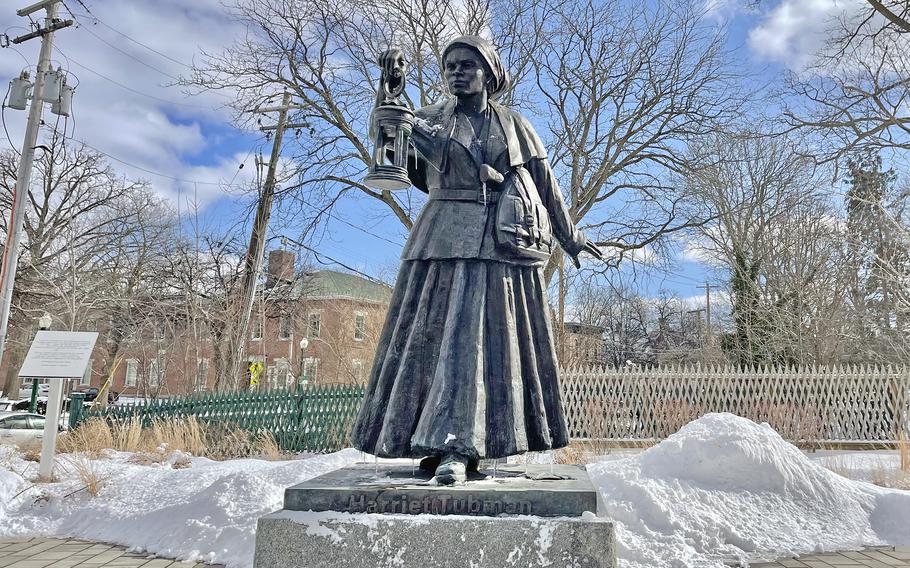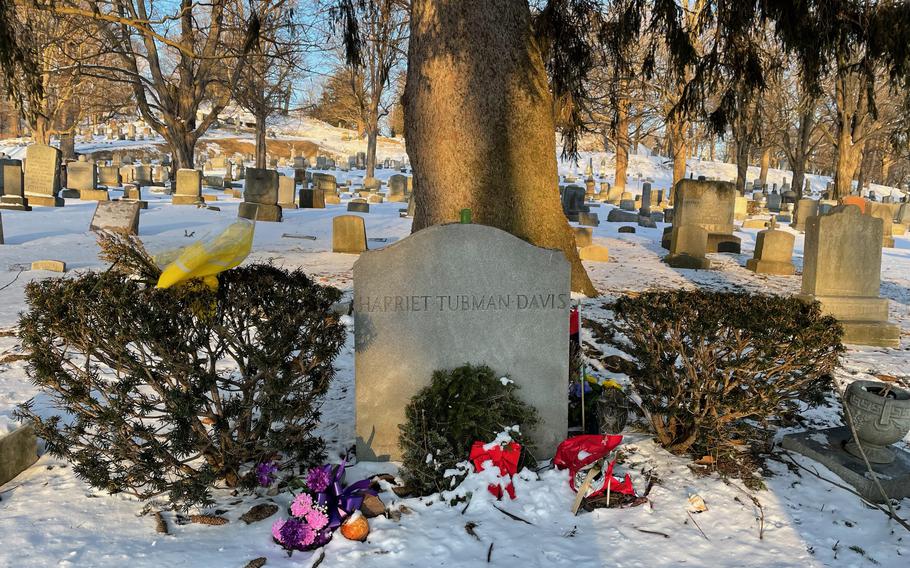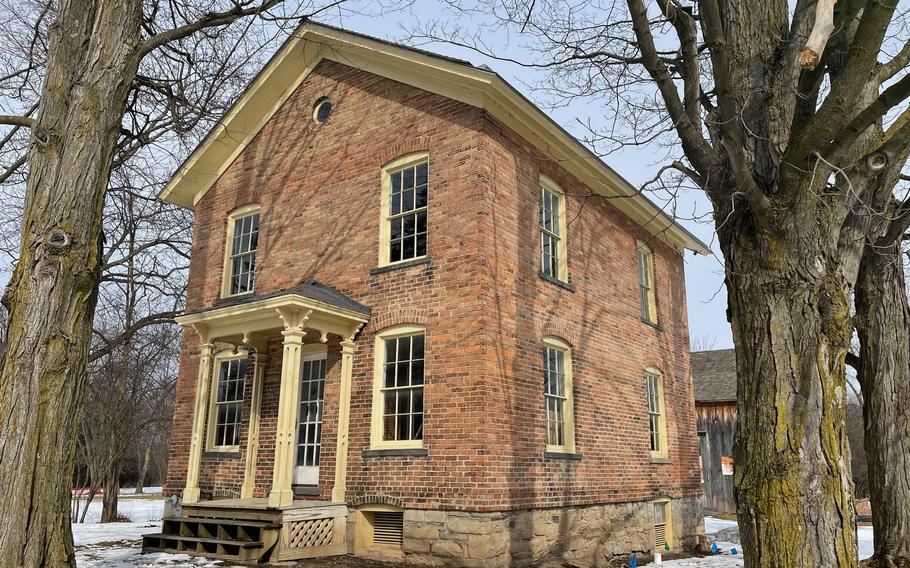
A statue of Harriet Tubman on the plaza of the New York State Equal Rights Heritage Center in Auburn, N.Y. (Andrea Sachs/The Washington Post)
On a numbingly cold day in upstate New York, Judith Bryant was eating a bowl of potato, parsnip and turnip soup at a cafe in downtown Auburn. In between spoonfuls, she talked about the town's most famous resident, who lived in what is now part of the Harriet Tubman National Historical Park. Judith also resides nearby, in a house that Tubman's nephew built, which was no coincidence.
"My grandmother was Harriet Tubman's grandniece," said the vivacious 85-year-old great-great-grandniece of Tubman, one of several descendants in the Finger Lakes area.
Highlight reels of Tubman's life often focus on the first half of her biography: her escape from slavery in Maryland, her valiant acts as a conductor on the Underground Railroad, her heroic feats as a Black woman in the Civil War. The 2019 film "Harriet," for instance, ends with the "Moses of Her People" leading Union soldiers in the Combahee River Raid in South Carolina, a military operation that liberated more than 700 enslaved people. However, the more than half a century she spent in Auburn - from 1859, when she purchased seven acres of land from a prominent political family, to 1913, when she died of pneumonia - is equally stirring.
"Auburn could be the sequel to 'Harriet,'" said Angela Daddabbo, co-founder and artistic director of the Auburn Public Theater, which displays a marquee poster of Tubman as if she were a headlining performer.
A variety of attractions illuminate Tubman's time in Auburn, where she was an active member of the community and in the equal rights movement that flourished upstate. Here, you can see where Tubman attended church, participated in a town hall meeting about garbage collection, cared for elderly Black people and, finally, after a tireless life, rested.
"This is the part of her story that tells the real Harriet Tubman," said the Rev. Paul Gordon Carter, manager of the Harriet Tubman Home, which is part of the National Park Service's historical site. "In Maryland, they talk more of her enslaved life. Here we try to enlighten people about her free life."
This year, Auburn is honoring the bicentennial of Tubman's birth with special events, such as exhibits and lectures. Programming started in February, during Black History Month; ramped up in March, her birth month and Women's History Month; and will continue through summer. The National Park Service has also planned celebrations at both of its Tubman parks - Auburn's and the Harriet Tubman Underground Railroad National Historical Park on Maryland's Eastern Shore. The festivities will run through September, or International Underground Railroad Month, which Maryland Gov. Larry Hogan declared in 2019.
"There's no one braver than Harriet Tubman," said Celeste Beatty, founder of Harlem Brewing Company and a presenter at Brave Brews, a festival of female craft brewers held the first weekend of March in Auburn. "These are hallowed, holy grounds."
Tubman is not literally on every corner, but close. On the walk from Cafe 108, the Auburn Public Theater's eatery, to the New York State Equal Rights Heritage Center, I passed a mural of the abolitionist on the Genesee Center building and a bronze statue dripping in icicles in the heritage center's plaza. Inside the former site of the Women's Educational and Industrial Union, Tubman appears in a gallery of illustrious New Yorkers who dedicated their lives to abolishing slavery or fighting for women's or human rights. She occupies a spot in the top row, alongside AIDS activist Larry Kramer, Eleanor Roosevelt and Emily Howland, a suffragist friend of Tubman's who lived in the neighboring hamlet that is now the Sherwood Equal Rights Historic District.
"Harriet stayed at Emily's on occasion, and they attended events together," said Larry Bell, a historian at Opendore, a museum in Sherwood. "Emily owned an album with a picture of a young Harriet Tubman." (The Smithsonian Institution's National Museum of African American History and Culture acquired the album.)
For the bicentennial, the equal rights center decorated its windows with hundreds of birthday cards made by schoolchildren from around the country. "Dear Harriet, It's your 200th birthday. Thank you for being a spy and a leader. You are the best!" one well-wisher wrote in pencil.
A few paces from the center is the Seward House Museum, the grand home of the family who sold Tubman the first parcel of land she had ever owned. Without their generous offer, Canada might have been the host of this bicentennial party. On a tour of the house, my guide, Linda Guinn, led me to the parlor, which was dressed to impress with gold-painted chairs and portraits of the main cast of characters: Elijah Miller, the wealthy judge whose marriage agreement for his daughter stipulated that the couple must move into his home; William Seward, the politician son-in-law; and Frances, the daughter, wife and fervid abolitionist.
The tour of the 30-plus-room Italianate mansion mainly centers on family life, career (as Abraham Lincoln's secretary of state, Seward was targeted in the plot to assassinate the president and several top bureaucrats) and interior design (all of the furnishings are original, with the exception of a few rugs). However, an exhibit called "Forged in Freedom: The Bond of the Seward-Tubman Families" delves into the friends' relationship and their shared mission to end slavery.
"Harriet Tubman passed through here quite a bit," Linda said, alluding to Tubman's multiple trips on the Underground Railroad. "They supported her with food and funding, and raised her niece while she was in the Civil War."
The Seward House was a way station on the route to Canada, one of several safe havens in Cayuga County. (My lodging, the Springside Inn, was most likely another.) On a winter's afternoon, the basement kitchen glowed warmly from the hearth, and the thick stone walls muffled the street noise. In the silence, I could imagine hearing the clattering dishes, scraping chairs and murmurs of travelers as they rested before continuing onward, through the darkness and into the light of freedom.
The day after my lunch at Cafe 108, I waited outside the Hilton Garden Inn for a driving tour of Auburn. Judith, Tubman's descendant, was behind the wheel, and Celeste, the visiting craft brewer, and her friend were in the back seat, grazing on fruit from the hotel's buffet. Judith started at Fort Hill Cemetery, where Tubman and several family members are buried, including her husband, Nelson Davis, and her brother William. A Norway spruce towered over the gravesite, its shaggy foliage providing protective cover.

Harriet Tubman, who died of pneumonia in 1913, is buried in Fort Hill Cemetery, not far from her property. (Andrea Sachs/The Washington Post)
"My grandmother and great-uncle planted it as a grave marker for their parents, adjoining Tubman's grave," said Judith, referring to Tubman's grandniece and grandnephew.
Visitors had left gifts for Tubman: a wreath with a red bow, a bouquet of purple flowers, a green candle and a black felt hat encrusted with snow. Celeste returned to the car with a pine cone, a flavor component she has incorporated in her beer. Judith, a steward of her ancestors' tree, asked Celeste whether she had found the cone or plucked it from a branch. Celeste assured her that she had retrieved it from the ground.
Judith revved the car and headed to Holland Stadium, which was named after Auburn native Jerome Heartwell Holland, the first Black person to play football at Cornell University (among other firsts), and the Booker T. Washington Community Center, which was established in 1927 for Black residents who were not welcome at the town's YMCA. At the Thompson Memorial AME Zion Church, which the National Park Service is restoring to its earlier glory, Judith curbed the car so we could take a closer peek at the church that counted Tubman among its congregation and officiated her funeral. The wood structure looked precarious, as if a wind gust could blow it down like a matchstick house.
A few miles away in Skaneateles, Judith pointed out the Fuller House, which had sheltered passengers on the Underground Railroad. For our final stop, we popped into the Willard Memorial Chapel. The 19th-century church does not have a Tubman connection, but we made an exception for the world's only intact chapel designed by Louis C. Tiffany and his father's company. Apologizing profusely, we left in the middle of the guide's talk; I had a 1 p.m. reservation at the Harriet Tubman Home, and Celeste was kicking off the one-mile craft brewery walk. Judith dropped me off, then booked it to the starting line of the beer crawl.
The Tubman Home is a collection of buildings owned and operated by the AME Zion Church and the National Park Service. Tubman, who had purchased 25 acres in addition to the original seven, had deeded her property to the church when she fell behind on payments. The National Park Service entered the picture in 2017, when it unveiled the 32-acre Harriet Tubman National Historical Park.
Carter, who was wearing a microphone and a gray sweatshirt dominated by an image of Tubman, gathered our group in the visitor center. We stood facing a long timeline of her life and benchmark events that led to the abolition of slavery. The reverend was an animated speaker who sprinkled new details into a familiar story. For example, during the Civil War, he told us that, in addition to Tubman's roles as spy, scout, nurse and cook, she was also an entrepreneur who sold pie and root beer to Union soldiers.
"Only 1 out of 1,000 people know that answer," he said, after polling our group about Tubman's wartime efforts. Not one of us guessed the last one.
Tubman's two-story brick residence still stands on her original farmland. However, the Home for Aged and Indigent Negroes was rebuilt in the early 1950s, and the infirmary was destroyed by fire in 1949. After Carter concluded his talk - "And that, my friends, is the story of Harriet Tubman Davis" - we could briefly step inside the entrance to the nursing home. (For health reasons, we could not linger indoors, and because of one bad seed who tried to sell images of the building, we could not snap photos of the interior.) Her residence is slated for renovation, but I walked around its exterior, wishing bricks could talk.

Harriet Tubman’s residence is part of the Harriet Tubman Home site. She purchased seven acres from the Sewards in 1859 and later bought an additional 25 acres. (Andrea Sachs/The Washington Post)
Following the tour, I considered catching up with the brewery crawlers. However, as I was preparing to leave, two sightseeing buses drove into the lot and unloaded a stream of passengers. Carter's dynamic voice rose above the din. I inched closer to listen, never tiring of hearing about the woman who was born enslaved and died an agent of freedom.
IF YOU GO:
Where to Stay
Springside Inn
6141 W. Lake Rd., Auburn, N.Y.
315-252-7247
The inn near Owasco Lake offers seven country-luxe rooms, plus the Oak & Vine gastropub. The lodge, which occupies the site of a former boys' school, was most likely a stop on the Underground Railroad. Ask the owners, Sean and Beth Lattimore, to show you the bulging binder filled with articles and scholarly materials about Harriet Tubman and Auburn. Rooms start at $135 a night, including breakfast.
Where to Eat
Cafe 108
108 Genesee St.
315-252-2233
This breakfast and lunch spot is part of the Auburn Public Theater, with proceeds going to the nonprofit performing arts venue. The cafe is also a community gathering place that hosts special events. Breakfast starts at $5; lunchtime sandwiches and wraps start at $11. For a lighter meal, grab a smoothie, homemade baked good or specialty coffee.
What to Do
Seward House Museum
33 South St.
315-252-1283
The museum, the former gilded home of abolitionists, runs guided tours on the hour, 10 a.m. to 5 p.m., Tuesday through Saturday. From June through September, the house is open Sundays, 1 p.m. to 5 p.m. Entry costs $14 per adult, with a discounted rate for seniors and Cayuga County residents, among other select groups. Children under 6 are free. Admission includes two exhibits: one about Harriet Tubman and the Sewards, and the other about voting rights.
Harriet Tubman Home
180 South St.
315-252-2081
Tubman's property includes a visitor center, her residence and the Tubman Home for Aged and Indigent Negroes. Two tours are offered by reservation Tuesday through Saturday, at 10 a.m. and 1 p.m. On open days, visitors are welcome to explore the grounds independently until 3 p.m. The tour costs $5; cash is preferred. The times and price are subject to change.